In April 1915, at a little-known beach in Turkey named Gallipoli, two legends were created. The first was the courage of the Australian soldier: the second was the wartime service of the Salvation Army.
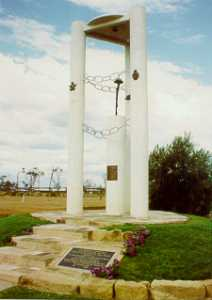
AWM P00329.001. Portrait of Chaplain Major William McKenzie, MC, of the Salvation Army, who was attached to the 4th Battalion, Australian Imperial Force, during the 1914-18 War.
It was in the First World War that the image of the Salvation Army chaplain, tending to the physical and spiritual needs of the Diggers wherever they were, was truly forged. The Salvation Army was already becoming widely identified as 'Christianity with its sleeves rolled up', and men like 'Fighting Mac' McKenzie typified that image. As chaplain to the 1st Infantry Brigade, Fighting Mac went ashore with the troops at Gallipoli. He saw horrors no man should see. He accepted responsibility with which no man should be burdened. In one three-day period, Fighting Mac conducted 647 funeral services. He was constantly in the front line -- after one funeral service he found three bullet holes in his hat. A grateful government awarded him the Military Cross for his work, a gallantry honour virtually unheard of for a military chaplain.
The Salvation Army did its work in every theatre of that terrible conflict. At Le Havre, in France, the famous 'HOP IN' sign made its first appearance. These were centres where the ordinary soldier could get a cup of tea and a bit of advice or encouragement if he needed it.
Salvation Army chaplains and workers gave without restraint or condition. They would hold religious services, pray with the soldiers, and counsel them. Without criticism or condemnation, they would also do their best to keep them out of bars, brothels and gambling halls.
The Salvation Army women did their part too. Dozens of nurses from Salvation Army homes such as Bethesda volunteered, and gave distinguished service in the Australian Army Nursing Service.
By the last year of the war, the Salvation Army was operating nearly five hundred hostels or rest centres, with more than eight hundred officers in the field. They had served in places as far-flung as Egypt, France, Belgium, India, Palestine and, of course, Gallipoli.
Their work did not go unnoticed at the highest level. When the terrible conflict was finally over, King George V personally dictated a letter to General Bramwell Booth in which he said:
By its work of love and mercy, in both peace and war, the Salvation Army has become honoured and endeared in the hearts of the nations of the world.
But it had achieved more than just praise from high places. The Salvation Army had won itself a place in the hearts of thousands of ordinary soldiers who had gratefully received help and comfort in their darkest hour.
No longer would Salvationists be pelted with rotten tomatoes at their public meetings. Gallipoli may have re-created Australia as a nation -- it had also re-created the Salvation Army in the minds of millions of Australians.
Australia emerged from the Great War with a new sense of identity, and with the knowledge that the world had changed forever. The soldiers of the cross who gave such gallant service in time of war were now equally accepted in time of peace as well.
The war to end all wars, the Great War of 1914–1918, did not end war -- it merely laid the foundation for a greater conflict. Ground down by the oppressive terms of the Treaty of Versailles and racked by depression, Germany welcomed the promises of the Nazi Party -- order, a better standard of living, work for all, and room for a recovering nation to grow.
Unfortunately, that room to grow was at the expense of others.
On 1 September 1939, Germany invaded Poland. On 3 September, Poland's allies, Britain and France, declared war on Germany. On the same day, Australia's Prime Minister, Robert Menzies, told the Australian people that as a consequence of Britain's action, they too were at war with Germany.
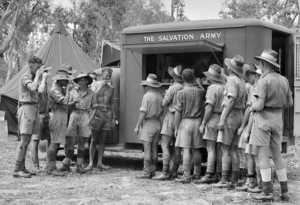
AWM 027747. Northern Territory, 1942. The Salvation Army had several vehicles fitted out for supplying cool drinks to troops in camp and on marches.
The Salvation Army went to work at home and on the battlefield. Home comforts, advice, support, and spiritual assistance were offered and gladly given to all those who asked for them. Salvation Army huts and canteens were set up wherever there was a need for them -- in training camps in Australia, in the deserts of North Africa, in the jungles of New Guinea. Wherever an Australian soldier, sailor or airman served, so did the Salvation Army.
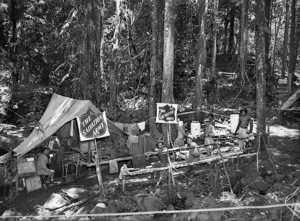
AWM 027002. Papua 1942. The Salvation Army in a forward area of the Owen Stanley Ranges. This very welcome tent, near Uberi, with its welcome cup of coffee and biscuits, was a great boon to troops sick or wounded, going back from the front.

AWM 007467. Tobruk, 1941. A group of Salvation Army and AIF personnel outside the Salvation Army hut.
One of the turning points of the early war years was the siege of Tobruk, and one of the most loved men present at that conflict was the Salvation Army chaplain to the 2/9th Battalion, Arthur McIlveen -- known to all and sundry as 'Padre Mac'. Padre Mac's secret weapon was an ancient wind up gramophone. He possessed only a few records. Unfortunately several were literally blown to bits by shellfire. Padre Mac taped them together on the B-side with sticking plaster and reckoned they were still worth hearing, despite an understandable reduction in sound quality.

AWM 007478. Tobruk, 1941. Salvation Army and AIF personnelloading a truck with Comforts Fund items for distribution to the troops.
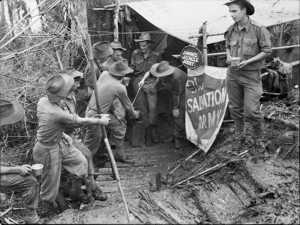
AWM 064248. Shaggy Ridge, New Guinea. ‘Jonno’s Jungle Joint’ -- the Salvation Army Red Shield hut on Shaggy Ridge showing troops of the 2/9th Infantry Battalion receiving a welcome cup of coffee.
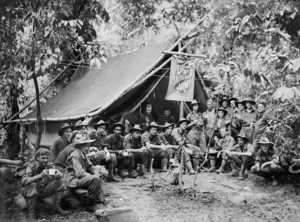
AWM 054515. Mubo-Salamaua area, New Guinea, 1943. Troops of the 2/6th Australian Infantry Battalion enjoy a rest and a cup of tea at the Salvation Army hut at Mat-Mat.
Of all the theatres of war where the Salvation Army served, none was more challenging than the Kokoda Track. At the Salvos own request, the Red Shield post was stationed where it was most needed, close behind the shifting front line. At Milne Bay, there were no less than fourteen Red Shield centres. At Wau, the Salvos were right in the thick of things -- eight of them were wounded when the Japanese forced a retreat after twelve days of some of the hardest fighting of the entire Pacific War.
The Second World War officially came to an end on 15 August 1945. More than twenty million people died during those six terrible years. The Salvation Army's work in this monumental conflict created its own lasting heritage. The memory of the Salvationists' selfless service would stay with an entire generation of Australians for the rest of their lives. But for the Salvationists themselves, their efforts were little enough compared with the sacrifices of the men and women who had answered their country's call in those darkest days.
Source: The Salvation Army, 1900–2000, A Century of Care
Editor’s Note: The Salvation Army’s soldiers of the cross have continued to offer spiritual comfort, advice and support to members of the Australian Defence Force in later conflicts and peacekeeping/peacemaking operations including Korea, Vietnam, Somalia and EastTimor.

AWM DNE/65/0074/VN. Bien Hoa, Vietnam, 1965. Soldiers of the Australian Army force in Vietnam enjoy a cuppa in the Salvation Army tent in the battalion headquarters. The sign on the tent reads: ‘Hop in, you’re welcome’.
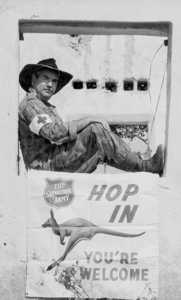
AWM MSD/93/0057/30. Somalia, 1993. Medic in a slouch hat sits in the window frame at the Salvation Army ‘HopIn’ centre.





